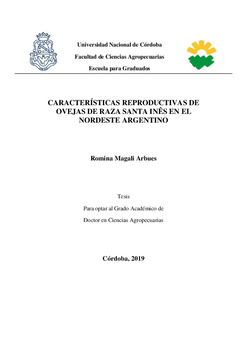| dc.contributor.advisor | Flores Quintana, Carolina Isabela | |
| dc.contributor.author | Arbues, Romina Magali | |
| dc.date.accessioned | 2022-07-27T17:19:21Z | |
| dc.date.available | 2022-07-27T17:19:21Z | |
| dc.date.issued | 2019 | |
| dc.identifier.uri | http://hdl.handle.net/11086/27568 | |
| dc.description | Tesis (Doctor en Ciencias Agropecuarias) – UNC- Facultad de Ciencias Agropecuarias, 2019 | es |
| dc.description.abstract | La producción ovina nacional está concentrada en tres grandes zonas: Patagonia, Pampa Húmeda y Mesopotamia. En el resto del país, que comprende las provincias del norte, noroeste y centro oeste, la explotación ovina es más bien complementaria a la caprina con predominio de razas productoras de carne como criollas y caras negras que producen lana de baja calidad por lo que la esquila no se justifica. La lana representa una complicación debido a las características del medio ambiente donde abunda el monte bajo y sucio, existe mayor prevalencia de miasis y es necesario realizar el desoje dos o tres veces al año. Los ovinos de razas tropicales deslanadas se introducen al país hace aproximadamente 10 años, sobre todo en la provincia de Chaco, norte de Corrientes, norte de Santa Fe, Misiones y algunas provincias del noroeste argentino. Las ovejas de éstas razas tienen la ventaja reproductiva de presentar un anestro poco definido, de menor duración o ausente. Esta característica reproductiva sumada a la ausencia de lana hace interesante su introducción a la región subtropical argentina. El objetivo de la presente tesis fue evaluar características reproductivas relacionadas con poliestrismo anual, respuesta a protocolos de sincronización y caracterización del perfil citológico vaginal de ovejas de raza Santa Inês en el nordeste argentino, comparándolas con la raza Ideal. Los porcentajes de ovejas ciclando fueron 70, 70 y 60 %, en la raza Santa Inês y 80, 10 y 20 % en la raza Ideal, durante otoño, invierno y primavera, respectivamente. La presentación de ciclos estrales fue diferente entre razas. El análisis estadístico de Chi2 tuvo un p valor <0,0001, indicando la asociación significativa entre las variables raza y estado reproductivo. Los protocolos de sincronización con esponja intravaginal durante 5 días, más 200 o 300 UI de eCG consiguieron porcentajes de celo superiores al 67 %. Con la utilización de 300 UI de eCG el intervalo al celo se acortó significativamente. Los porcentajes de preñez fueron altos y no hubo diferencia significativa entre dosis. Las preñeces dobles no superaron el 18%. En la citología vaginal se reconocieron células parabasales, intermedias profundas y superficiales y superficiales. Las modificaciones en las frecuencias de cada tipo celular no permitieron determinar la fase del ciclo estral. | es |
| dc.description.abstract | National sheep production is concentrated in three main areas: Patagonia, Pampa Húmeda and Mesopotamia. In the rest of the country, which includes the northern, northwestern and central western provinces, sheep exploitation is rather complementary to the goat with a predominance of meat-producing breeds such as Creoles and black faces that produce low quality wool, so Shearing is not justified. Wool represents a complication due to the characteristics of the environment where the low and dirty mountain abounds, there is a higher prevalence of myiasis and it is necessary to perform the desolation two or three times a year. Sheep of deslanadas tropical races are introduced to the country about 10 years ago, especially in the province of Chaco, north of Corrientes, north of Santa Fe, Misiones and some provinces of northwestern Argentina. The sheep of these breeds have the reproductive advantage of presenting a poorly defined, short-lived or absent anestrus. This reproductive characteristic added to the absence of wool makes its introduction to the Argentine subtropical region interesting. The objective of this thesis was to evaluate reproductive characteristics related to annual polystrism, response to synchronization protocols and characterization of the vaginal cytological profile of sheep of the Santa Inês breed in northeastern Argentina, comparing them with the Ideal breed. The percentages of cycling sheep were 70, 70 and 60%, in the Santa Inês breed and 80, 10 and 20% in the Ideal breed, during autumn, winter and spring, respectively. The presentation of estrous cycles was different between races. The statistical analysis of Chi2 had a p value <0.0001, indicating the significant association between the variables race and reproductive status. Intravaginal sponge synchronization protocols for 5 days, plus 200 or 300 IU of eCG achieved heat percentages greater than 67%. With the use of 300 IU of eCG the interval to heat was significantly shortened. Pregnancy rates were high and there was no significant difference between doses. Double pregnancies did not exceed 18%. In vaginal cytology, parabasal, deep intermediate and superficial and superficial cells were recognized. The modifications in the frequencies of each cell type did not allow to determine the phase of the estrous cycle. | en |
| dc.format.extent | 159 h. : gráficos, tablas, fotografías color | |
| dc.language.iso | spa | es |
| dc.rights | Attribution-NonCommercial-NoDerivatives 4.0 Internacional | * |
| dc.rights.uri | http://creativecommons.org/licenses/by-nc-nd/4.0/ | * |
| dc.subject | Reproducción animal | es |
| dc.subject | Oveja | es |
| dc.subject | Ciclo estral | es |
| dc.subject | Anestro | es |
| dc.subject | Sincronización del celo | es |
| dc.subject | Zona subtropical | es |
| dc.subject | Argentina | es |
| dc.title | Características reproductivas de ovejas de raza Santa Inés en el nordeste argentino | es |
| dc.type | doctoralThesis | es |
| dc.description.fil | Fil: Arbues, Romina Magali. Universidad Nacional de Córdoba. Facultad de Ciencias Agropecuarias; Argentina. | es |
| dc.description.fil | Fil: Flores Quintana, Carolina Isabela. Universidad Nacional del Nordeste. Facultad de Ciencias Veterinarias; Argentina. | es |





